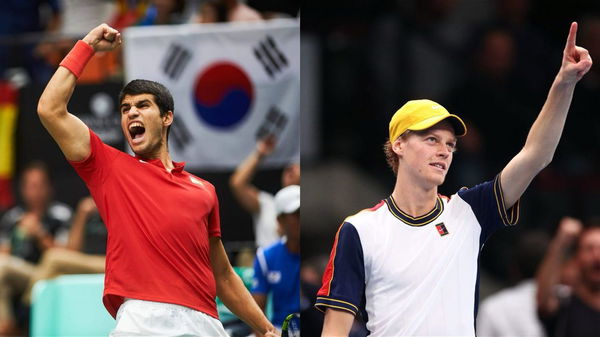
via Imago
Image Credits: Imago

via Imago
Image Credits: Imago
Not so long ago, men’s tennis was all about teeth-grinding endurance and never-ending rallies. Now, things are changing. With the new generation cropping up, players are rewriting the script and bringing in more aggression and firepower than ever before. At the heart of this revolution lie two skilled stars Jannik Sinner and Carlos Alcaraz, whose precision inside the baseline compelled the rest to reevaluate their own game. As they rise to the apex of the sport, Kim Clijsters explains how they differ from the Serbian icon Novak Djokovic and her reasons might change the way you look at the sport!
Clijsters recently joined veteran Andy Roddick’s Served podcast to discuss an interesting transformation in men’s tennis. Reflecting on how the game has become more aggressive, dynamic, and fast-paced after the Big Three era, she found an increasing focus on adaptability and shot-making. This former Belgian player’s reference to Novak Djokovic was particularly relevant, as the Serb is known for his aggressive baseline play, powerful groundstrokes, and exceptional defensive skills. A resilient counterpuncher, Novak constructs his match points strategically, relying on extended rallies to wear down his opponents. In contrast, Italy’s star player and ATP number one, Jannik Sinner is also an aggressive baseliner. He has developed a distinct ability to pick his spots for attack, a skill that has earned him significant victories in his career. Spaniard Carlos Alcaraz, another rising star and ATP number three, offers an even more high-risk, high-reward playstyle, aiming to finish points early with fierce aggression.
“Correct me if I’m wrong,” Clijsters began, “but I feel like men’s tennis is… and I’m not saying it’s becoming more like women’s tennis, but the guys are hitting the ball so much harder. They’re not standing as far behind the baseline anymore—maybe Medvedev, yes—but not like they used to years ago. Some still do, but when you look at matches, take Novak, for example. The way he builds points—he hardly hits two or three shots to the same corner. It’s just… yeah, the game is changing, especially for guys like Alcaraz and Sinner.” But, why did she say so?
ADVERTISEMENT
Article continues below this ad

Clijsters explained this transformation, highlighting the growing aggression in modern tennis: “Whenever they get a short ball, they’re going for the winner. I remember when we were younger, it was more about keeping the rally going, waiting for the right shot. But now, guys like Sinner and Alcaraz are just so aggressive.” Interestingly, this new generation of players also departs heavily from legendary Roger Federer’s style, which showcased power with finesse and variety – borrowing some elements from classic serve-and-volley too. Unlike the Swiss stalwart, who often used touch and creativity to construct points, Sinner and Alcaraz rely more on pace and offensive style to dictate the course of their play.
Part of this shift is owing to how men’s tennis evolved from the 1970s. The era’s signature flat shorts, zero spin, and low margin has given way to the new generation players who are able to generate more topspin and power. The reason? A different grip. The distinctive variation in angles from the almost-exclusively continental grip to extreme Western grip gives players more flexibility on the wrist. Add to that a heavy body rotation and you have a spin-dominant forehand without compromising speed on groundstrokes. But as Clijsters’ words point out, a gradual shift is developing – a shift that borrows elements from the women’s tour.
ADVERTISEMENT
Article continues below this ad
What’s your perspective on:
Is the aggressive style of Sinner and Alcaraz the future of men's tennis, leaving Djokovic behind?
Have an interesting take?
Is men’s tennis, led by Jannik Sinner and Carlos Alcaraz, gradually adopting WTA’s playing style?
Discussing the key differences between men’s and women’s tennis, Serena Williams’ former coach Patrick Mouratoglou focused on the forehand to dissect parameters like spin usage and movement speed. According to Mouratoglou, men apply more spin and hit the ball with greater height which tempers the fast ball with control. On the other hand, women players could afford to play faster and flatter, with less spin, since only the creme-de-la-creme – like Coco Gauff – have the aggression and physicality to counteract such speed. For them, it is high risk, high reward. Mouratoglou found this style in Aryna Sabalenka’s game whose average forehand speed is higher that even those of Carlos Alcaraz, Jannik Sinner, and Novak Djokovic.

via Imago
Carlos Alcaraz celebrates winning the first set during his Quarter-final match against Djokovic in the Rod Laver Arena Australian Open, Day Ten, Tennis, Melbourne Park, Melbourne, Australia – 21 Jan 2025 PUBLICATIONxINxGERxSUIxAUTxHUNxGRExMLTxCYPxROUxBULxUAExKSAxONLY Copyright: xRachelxBach/Shutterstockx 15108797ff
But the same playing style if implemented on the ATP Tour could spell disaster for top stars. Physical edge is less of a concern on the men’s roster and more of a given; rapid court coverage and aggression are par for the course there. Hence, on paper, attempts at faster winners could spell a disadvantage for players like Alcaraz or Sinner, which could be turned on them just as as quickly. As the Frenchman said: big risks with minimal rewards. But a sweet spot – as Clijsters pointed out – has begun to emerge.
ADVERTISEMENT
Article continues below this ad
Spin in place, the rhythm and pace in men’s tennis have begun to pick up ever so slightly. Adding to that is a resurging trend of longer cross court rallies, volleying and half-volleying, crossing within the baseline and rushing to the net to polish off points at the drop of a hat. Dialed up aggression is becoming the name of the game. Carlos Alcaraz and Jannik Sinner have already proved that they’re up to it – with the ageless Djokovic to boot. Will the rest follow suit?
ADVERTISEMENT
ADVERTISEMENT
ADVERTISEMENT
ADVERTISEMENT


Is the aggressive style of Sinner and Alcaraz the future of men's tennis, leaving Djokovic behind?